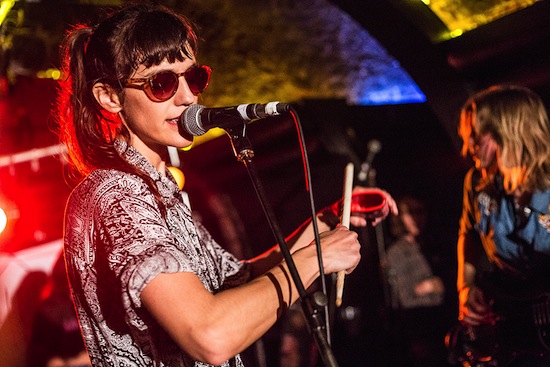Las Kellies
Trying to decide what bands to see by reading the programme is (almost) hopeless
The Great Escape is a new music festival, featuring literally hundreds of bands, many of them unsigned. The chances are then that there will be a lot of acts on the bill that you’ve never heard of, or at least never heard. As such, you are more reliant than usual on the hefty programme booklet that lurks at the bottom of your complimentary Great Escape tote bag, somewhere between the emergency tub of Skittles and the folded card that tells you when the last night bus to Hayward’s Heath leaves, presumably in case things get really bad.
Now I don’t know whether the bands or their management are invited to submit pithy, three-line summations of their art to the programmers, or whether it is the duty of some poor, half-mad intern to listen to every act in the line-up and attempt to nail their distinguishing features and key attributes for the benefit of the discerning punter. If the latter, you can maybe forgive the desperate "can-I-go-to-lunch-now" vapidity of "A band from Carouge, whose music combines drum and guitar riffs in an eclectic manner with a lively rock n’ roll tune," or "with their marvellous indie sound and soaring choruses they continue to keep us dancing." Still, one wonders if anyone was convinced that they must see the band whose blurb read, "Combining an enormous versatility with a consistent and captivating sound," or indeed, "formed from the notion of opposites coming together to complete perfect wholes; they are unique but find unison in one another." "Like Mumford & Sons, this London band offer a glimpse of the pastoral with their infectious semi-acoustic ditties" at least offers a clear warning to stay away. My favourite? "Inspired by music ranging from Death Grips to James Blake, they’re more than just a band, they’re a filter." Well, that’s handy, but will they fit in my plughole?
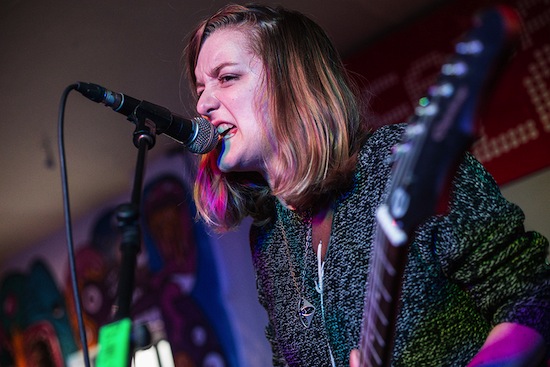
HSY
Occasionally though, something leaps out at you and does make you want to see if they can live up to their audacious description. So it was that I found myself on Thursday afternoon watching Toronto sludgemeisters HSY (pronounced ‘Hussy’), whose programme entry claimed that they were "reminiscent of Section 25 and the Melvins." That’s intriguing to say the least, and blow me if they don’t almost pull it off. Their set at the Blind Tiger sprawls in pre-Nevermind grungy hardcore, but with a darkwave edge provided by triggered beats alongside regular crashing drums, and echoing flanged bass that re-routes their graffiti-scrawled sonic juggernaut into abandoned streets with old newspapers blowing through brutalist concrete architecture. Over churning industrial rhythms the two guitarists – Jude and Anna – share vocals, with Anna in particular capable of some chillingly raw, throat-shredding screams. Their music harks back to Psychocandy and Death Valley 69-era Sonic Youth, via murky nights in Camden watching Silverfish or Babes In Toyland probably before any of HSY were even born; but far from making me feel old, they provide a bracing tonic as the weekend gets underway.
Deathcrush live up to their name
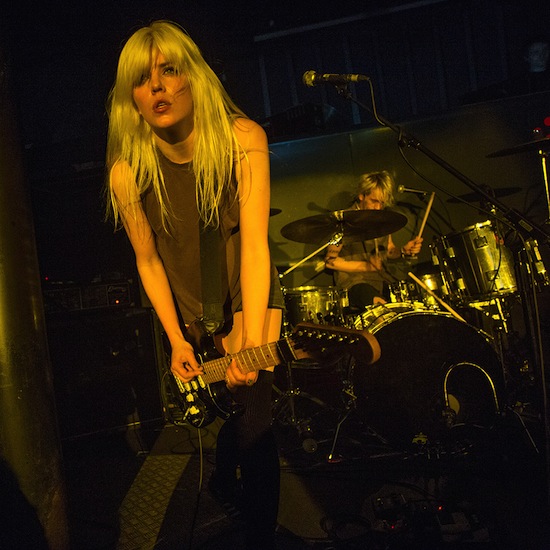
Deathcrush
On Thursday night the Hope is packed tighter than a Metropolitan Police kettle for the Norwegian punk-metal trio, with the queue still snaking down the hill towards the seafront. The upstairs venue has developed its own micro-climate, with the air 10% oxygen and 90% teenage sweat, the near-tropical heat and humidity playing merry hell with one’s leathers. It isn’t however actually life-threatening, or anything other than good-natured, but the sense in which Deathcrush live up to their name is that if you’re a couple of young girls and a guy from Oslo and you’re calling yourself Deathcrush, then you have to really rock. Let us be clear: there is no room for half-hearted levels of rocking, of the sort that might be considered perfectly acceptable and smokin’ in, say, Belgium or Switzerland. No, if you are called Deathcrush in Norway and you do not want to be burnt as a heretic by righteously offended Mayhem fans, then you need to Rock Hard.
Happily, Deathcrush are astonishing. Linn Nystadnes and Ase Royset both attack guitars and microphones, but it’s Linn who takes lead vocals and the lion’s share of our attention, with her blonde mane whipping over the worshipful heads of the boys in the front row, striking perfect skate-punk pop goddess poses before launching herself into the crowd with violent, confrontational joy. Her near-rapped vocals are the missing link between Lydia Lunch and Salt n’ Pepa; "This is just for fun – is it just for fun?" she repeats, on ‘Lesson #16’ (all their songs are "lessons"), nailing the uncomfortable, edgy thrill of their performance. Then they all break into visceral screams, pummelling us with filthy streamlined noise that draws equally on New York no wave and Scandinavian death metal, with a hardcore energy that recalls both Black Flag and Atari Teenage Riot.
Technical difficulties are inevitable
With each venue hosting up to ten bands a day for three days, and rapid changeovers between half-hour sets as they desperately try to stay on schedule, it’s no surprise to see sound engineers with thousand-yard stares more commonly expected on battle-hardened combat veterans, and to watch bands stumbling around on stage obviously unable to hear a note they’re playing. In this situation, it’s not so much a damning indictment when things do occasionally break down as it is a credit to all concerned that mostly it sounds okay and runs on time.
One can’t help but feel sorry for East India Youth, however, who played four shows across the weekend and was apparently blighted by gremlins and bad luck for the first two of these. I catch him on Thursday night, at the Quietus’ showcase at the Green Door Store, where technical problems delay the beginning of his set and a couple of false starts build up the wrong kind of tension among the capacity crowd. Actually, once he gets going, Will Doyle delivers an intermittently riveting performance, with his shimmering electro-techno-folk anthems breaking through like the brief bursts of sunshine that occasionally awaken a typically cloudy and damp English spring. It’s clear though that he’s far from happy, to the extent that when he works out his anger by thrashing away at his bass guitar, and the normally cool and collected Doyle almost resembles a young Wilko Johnson, not only for his schoolboy mop of hair and modish suit and tie, but for the bug-eyed, feral intensity of his playing.
Earlier in the evening Grumbling Fur play a superlative set of electro-organic, elemental place music that should be the perfect match for East India Youth’s more glacial, suburban take on the form. The duo come over like Depeche Mode on laudanum, not only because Daniel O’Sullivan’s vocals occasionally take on the rich, fallen angel quality of Dave Gahan if he’d been a wandering Lakeland poet, but also because, on the likes of ‘Protogenesis’ and ‘Dancing Light’ Grumbling Fur make epic, aching electronic folk music for new towns and traffic islands, murder ballads for out-of-town shopping centres and leisure complexes, and Baptist hymns to Ballardian metroland and the overground rail network of outer London. The complex clapping rhythm of ‘The Ballad Of Roy Batty’ feels like an initiation into a persecuted, underground religious cult that takes Blade Runner as their gospel and Gary Numan as an avatar of the divine replicant.
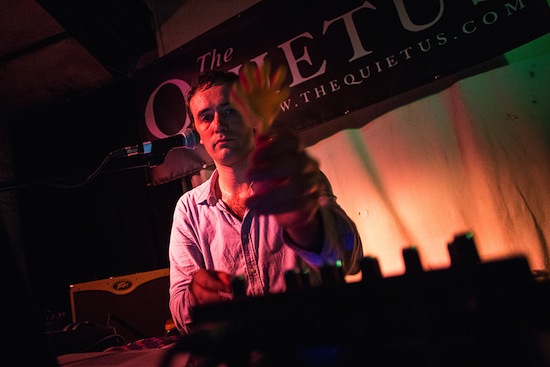
Grumbling Fur
Later in the weekend, on Saturday night, Trans also fall victim to technical problems in the Dome’s Studio Theatre. Bernard Butler, Jackie McKeown and company soldier on, but the stress inevitably impacts on the interplay between them. The nature of their art – three-chord pop songs that extend into open-ended, semi-improvised twin lead guitar codas – inevitably means that the quality of their shows will vary, and while their last Brighton show in March was a revelation, this time they don’t soar half as high. Not that their Velvet Underground–Television–Modern Lovers routine doesn’t still charm, but poor onstage sound and the pressure of a tight forty-minute slot rapidly trickling away certainly dampen their wings.
The French like a stylish guitar
Friday kicks off in fine form with an early afternoon show from Parisian psych-glam-dreampop quartet Moodoïd. It’s pretty hard to have any kind of exciting visual stage presence when you’re playing in front of a huge Amazon banner in the brightly-lit Brighthelm Centre, but with all four members resplendent in glittery face paint and frontman Pablo Padovani sporting a sparkling silver lamé suit, Moodoïd make the room their own. And even with statuesque bassist Clemence Lasme, and the two ladies both known only as Lucie on keyboards and drums respectively, Padovani still manages to be the most glamorous member of a most glamorous band, pouting and thrusting with a fey, slightly self-mocking narcissism and the art school puckishness of Marc Bolan or Syd Barrett, or at least the Blow Monkeys’ Dr Robert. It helps too that he gets through a gorgeous selection of expensive looking guitars, including a couple of shining twelve-strings and, best of all, a white nine-string Vox teardrop model that Brian Jones wouldn’t have sniffed at.
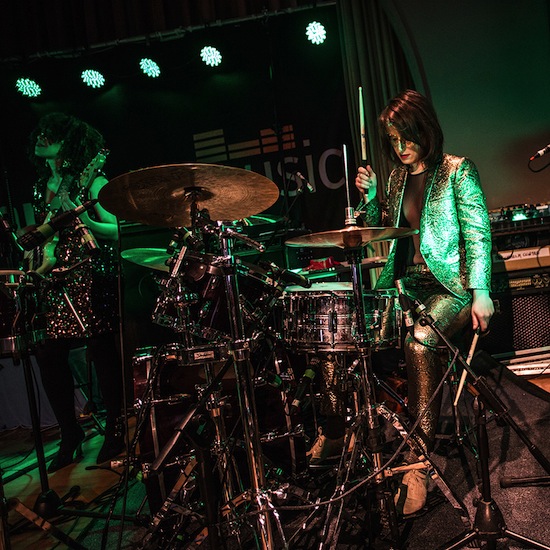
Moodoïd
Padovani is also a touring member of Melody’s Echo Chamber, and Moodoïd are cut from similar sonic cloth, playing shimmering soft psych with a distinct shoegaze influence, even if their performance is as far from shoegazing as could be imagined. Traces of tropicalia and the artier end of new romanticism also shine through, while twelve-string serenades like ‘Je Suis La Montagne’ recall the Brian Jonestown Massacre if they switched from monochrome to Technicolor. Meanwhile live highlight ‘De Folie Pure’ mixes Europop, Bollywood and tribal psychedelia in a way that’s utterly irresistible, and very French.
Later on at 10 Below, Padovani’s fellow countryman Orval Carlos Sibelius models a most attractive powder blue Gibson with aplomb. He knows how to handle it too, conjuring intricate psychedelic tapestries of surprisingly emotive pop, backed by a tight, instinctive band that includes a trombone player for those Love/Teardrop Explodes stabs of assertive brass. Too many bands nowadays think psychedelic music begins and ends with a one-chord Spacemen 3 drone, so it’s good to have the likes of Sibelius to remind us that it can also be about odd, twisting melodicism, often recalling cult 1990s baroque rock duo Cardinal.
September Girls are actually from Ireland
Alright, this may seem quite a minor personal revelation, but for some reason I’d always thought they were American. Finding out that they’re from just across the water, and not actual physical neighbours of kindred spirits the Dum Dum Girls and Warpaint, endears this band to me a lot more. It was when I saw them playing at the Music from Ireland Showcase at Audio on Friday afternoon that my keen journalistic instincts uncovered this hitherto buried truth; also, their darkly melodic pop tunes come across a lot better live than on record, with each member getting a chance to sing lead and conveying the sense of a tight-knit gang of talented friends competing to write the coolest, catchiest song. All dressed up in stylish monochrome Victoriana, the closest comparison is to the mighty Go-Gos, if they’d gone-gone down mid-80s glam-goth psychedelic club Alice in Wonderland. I hope they get the success they deserve, as these are truly girls for all seasons.
When a Finnish woman tells you that this drink is dangerous, it probably is
Music Finland is the main regional partner at TGE 2014, with a brace of Finnish artists appearing over the weekend, and several strands within the convention programme promoting the Finnish music industry. This includes a party on Saturday to celebrate Helsinki’s Flow Festival in August, which I have to say looked like a marvellous event. But I’m also rather intrigued by the free shots of mysterious black liqueur lined up on the bar. "What is it?" I ask our extremely blonde and Nordic-looking hostess. "It is very dangerous," she replies, with what I take to be a challenging twinkle in her eye. So I try one. And another. And a few more. It turns out to be Salmiakki Koskenkorva, colloquially known as Salmari; basically a pre-mixed cocktail of vodka and salted liquorice that became the alcopop-like drink of choice for Finnish teenagers in the 1990s. I imagine the taste falls into the "love it or hate it" category, and despite my enthusiastic encouragement to any music industry types foolish enough to try to "network" with me, I seem to like it more than most. And I hate to see it go to waste.
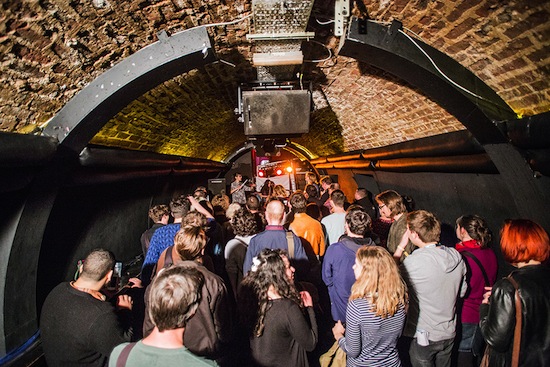
Las Kellies
I do not however allow the free drink to distract me from my duty, and arrive present and correct at the Fire Records showcase at the Tube; well, I somehow miss Keel Her, but I do catch Scraps’ beguiling electro-pop, and the enthusiastic and enjoyable ramshackle rock of the dreadfully named Scott & Charlene’s Wedding. Best of all is Las Kellies’ Argentinian blend of the B-52’s and ESG, which has me dancing like a goon down the front before suddenly ducking gracelessly out on remembering that I should really start queuing to get into Fat White Family’s first set of the night at Coalition next door. No chance; even the delegates’ queue practically stretches down the beach and off the edge of the pier. There’s also little possibility of me keeping going till 2.30 am for their late set at the Haunt, especially as that would mean standing through surprise special guests Peace beforehand. I mean, there are limits.
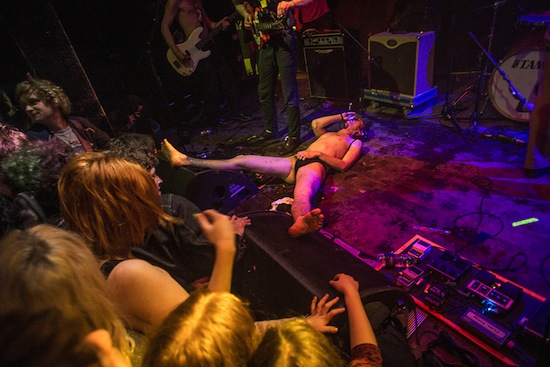
Fat White Family
Instead I march firmly west and finish off my evening at the Concorde 2, with the Hold Steady; a band far from currently fashionable and I dare say the better for it. And although I must admit I haven’t thought much about them in recent years, I can’t regret my choice. The Hold Steady still put on a storming show, and the Concorde is far enough from the town centre that you have to make a certain effort to be there, ensuring that while the (pretty big) venue is only half full, it’s mostly filled by loyal fans who receive the likes of ‘Southtown Girls’ and ‘Stay Positive’ – as well as songs from this year’s Teeth Dreams – with noisy, reckless enthusiasm. There’s a charming chemistry and contrast between the musicians – long-haired, Replacements-like blue collar rockers all – and nerdy, hyperactive, balding and bespectacled vocalist Craig Finn, who if this were a heist movie would inevitably be nicknamed "the Prof" for his wordiness and all those fancy books he always has his nose buried in when he should be following the baseball scores or something.
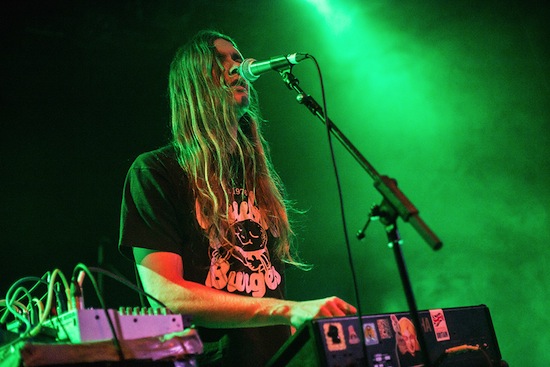
Jaakko Eino Kalevi
Oh, and I do see one Finnish act; Jaakko Eino Kalevi at the Prince Albert, whose stylish, hypnotic cold wave dream pop and deep, chocolatey singing voice is strongly reminiscent of John Maus. It’s strange then that he looks like a stringy-haired, weed-addicted slacker as he shuffles around the stage, instead of being darkly tormented in a dinner jacket (he could at least smoke skunk through a cigarette holder). His best song has the incredibly catchy chorus, "You don’t have to say you love me; just show me how flexible you are," and I like the fact that I can’t tell if it’s intentionally funny or not.
Only one man in the Netherlands has ever heard of the Jesus and Mary Chain
…Apart from the three members of ace garage-punk band Traumahelikopter obviously, as they pull off an impressive version of ‘Blues From A Gun’ (not the most obvious JAMC song to pick, either). But beforehand, when they ask us if we’ve ever heard of the Jesus and Mary Chain, they seem genuinely surprised at our collective, "Uh, yeah. Duh." They then tell us that when they play in the Netherlands there’s only ever "one weird old guy" who has heard of the seminal ’80s indie band. Traumahelikopter then finish with a song by the Ramones (‘Commando’) who presumably don’t have the same Dutch recognition problem.
They’re followed by one of the most impressive bands of the festival, The Oscillation. I’m only familiar with this psychedelic outfit from their 2007 debut Out Of Phase, which was an excellent but mostly electronic and synthesised album in the Death In Vegas mould. Then they were largely a solo project of Demian Castellanos; now, in the live forum at least, he’s leading a three-piece rock band, with guitars set to stun and the keyboard set-up barely touched all night. Playing before a backdrop of swirling projections, they capture the hammering intensity of early Spacemen 3, rather than the soporific sway that most of the imitators of that much-imitated band emulate. There’s much more complexity to their playing then there was to Sonic Boom’s boys too, with some great gurning lead drumming from Valentina Magaletti. I also note something of the unfulfilled potential of the occasionally great Lupine Howl – the late ’90s band formed by sacked Spiritualized/Julian Cope band members. Like Traumahelikopter, The Oscillation pull out an inspired cover – in their case, the psych-punk classic ‘Somewhere To Go’, originally recorded by former Brighton resident the late Mick Farren and his band the Deviants. And it’s a great number to have in your head as you walk out into the Brighton night; looking for somewhere else to go, one more late night drink, one more band playing in a pub back room somewhere, somehow, the festival going on forever.
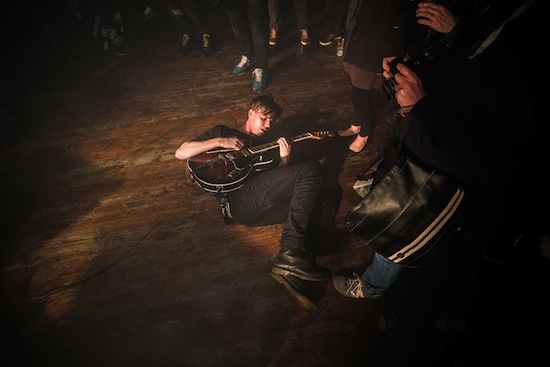
Traumahelikopter
With thanks to Erik Luyten for his photography

